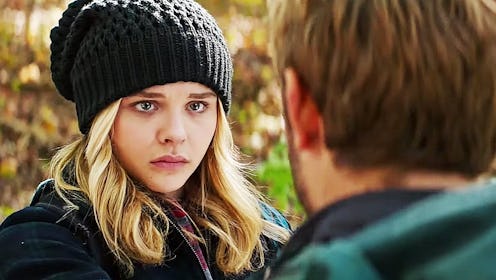Entertainment
What Sets 'The 5th Wave' Apart From 'Hunger Games'

Just as Twilight set off a trend of adolescent literature starring vampires — which then expanded to all supernatural beings — The Hunger Games kicked off a fad for futuristic dystopias starring young women-turned-saviors of humanity. But not all dystopias were created equal: The Hunger Games was among the first, and remains among the best, yet many of those that followed took different routes. Just look to Divergent with Shailene Woodley, or the upcoming Chloe Grace Moretz alien-invasion thriller The 5th Wave. For The 5th Wave isn't just another Hunger Games spinoff — if you're searching for a Suzanne Collins parallel, it's more like the Quarter Quell come to life, expanded across an entire planet. Just as the Hunger Games arena was set up as a clock, with different challenges arising each hour, the alien invasion of The 5th Wave arrives in five separate installments designed for maximal damage.
Though The 5th Wave — based on Rick Yancey's novel of the same title — takes place in the present day, the alien invasion from which the film draws its name quickly renders all technology useless, provokes a biblical plague, and colonizes the minds of even the most innocent-looking humans. It does bear similarities to The Hunger Games; heroine Cassie Sullivan (Moretz) sets off on a quest to rescue her little brother, much as Katniss stepped in on Prim's behalf in the first Hunger Games installment, and the broader humanity-in-peril theme remains the same in both novels. But the differences between the two novels-turned-films reveal that The 5th Wave isn't just another Hunger Games facsimile.
1. The Threat Comes From The Outside, Rather Than Inside
While humans turned on each other during the rebellion of The Hunger Games, the earth's population is subjected to an alien invasion in The 5th Wave. The threat to civilization comes from outsiders arriving on earth and wreaking destruction, rather than nations fighting against each other.
2. It's All About Surviving The Crisis Instead Of Its Aftermath
Though Katniss eventually overthrows the Capitol in The Hunger Games, the series picks up nearly 75 years after the rebellion has quieted. The actual war has already ended, and citizens of Panem must cope with the aftermath. But in The 5th Wave, the crisis has only just begun and it's all about surviving the impending alien invasion.
3. The Waves Aren't Confined To An Arena
Despite my initial comparison between the waves of The 5th Wave and the Quarter Quell of Catching Fire, the truly terrifying part of the former is that its various phases of destruction are not confined to an arena. There are no casual bystanders like there are watching the Hunger Games on television across the Capitol. Everyone is implicated in the Others' invasion in The 5th Wave.
4. The Heroine Doesn't Know Who Her Allies Are
In The Hunger Games, Katniss has staunch allies in Haymitch, Cinna, Peeta, and Gale (though the latter two are compromised at different moments). But in The 5th Wave, any person could be body-snatched at any moment, finding their mind and actions turned against those they love. So our heroine Cassie must spend sort the good from the bad and the human from alien before she has a prayer of rescuing her brother.
5. Two Words: Child Soldiers
Sure, The Hunger Games recruits teens to fight each other to death for the amusement of the Capitol's residents and to keep the outer districts in line. But The 5th Wave goes even further: The Others, the invading aliens, make supersoldiers of even younger children. Cassie's brother Sammy is kidnapped for such a purpose, and he's just five. Child soldiers are a terrifying reality, and rarely does a work of fiction delve so deeply into the problem.
Nothing is safe from the waves; this invasion is terrifying precisely because it targets everything of importance to human civilization, from technology to its very population. Like The Hunger Games, The 5th Wave is dark, but it's a different kind of dark. Apparently, there is sufficient space for multiple interpretations of a post-apocalyptic society in adolescent literature — teen novels have gotten pretty morbid.
Images: Columbia Pictures (6)